For varying reasons, Episodes 17 through at least 23 have a reputation so poor that many fans skip them outright when rewatching the series, Twin Peaks Episode 21 is no different. The existential tone of dread seems nearly absent, and Twin Peaks becomes a fun, melodramatic farce as a result. The high melodrama and silliness have always been a part of Twin Peaks episodes—just ask Lucy which phone is going to receive a transfer—but because it’s less anchored in reality, the stakes feel less real.
But thanks to Season 3 and its difficult-to-quantify use of magical realism, we can now see this period of Season 2 in a new light, and we don’t even need to ret-con anything. It’s easier to see how these episodes are less “bad” than they are simply out of balance.
The Thin Barrier Between Worlds Has Always Been Here
Based on probable evidence of shifting or multiple realities in Season 3, and similar evidence on display in The Secret History of Twin Peaks as early as the Lewis and Clark expedition, one could say that the barrier’s always been thin between Twin Peaks and Lodgespace. In particular, Part 8’s explosion—and also when Phillip Jeffries went to one of “their” meetings in Fire Walk With Me—happened before the Season 2 episodes. The fact that odd magical realism can happen in Twin Peaks is easy to justify. But why so pronounced in these episodes? Because this is the period of time between when BOB’s been released from Leland and has yet to be contained in Cooper’s doppelganger.
In Twin Peaks Episode 21, BOB and his unbridled want is literally loose in the air. And since his appetite is insatiable, and he’s not focused through one single person, his want is able to permeate anywhere the wind blows like a poem about water read over the radio. Characters could easily be outwardly manifesting their hidden wants and fears into observable tangibility. Whether characters want to grab power, become someone else, go back in time, avoid their trauma, or feel powerless to their fears, it’s happening as strongly and vividly as they “want” it to. Their dreams can come true, and so can their nightmares. And this episode focuses on a number of extreme fears brought to life.
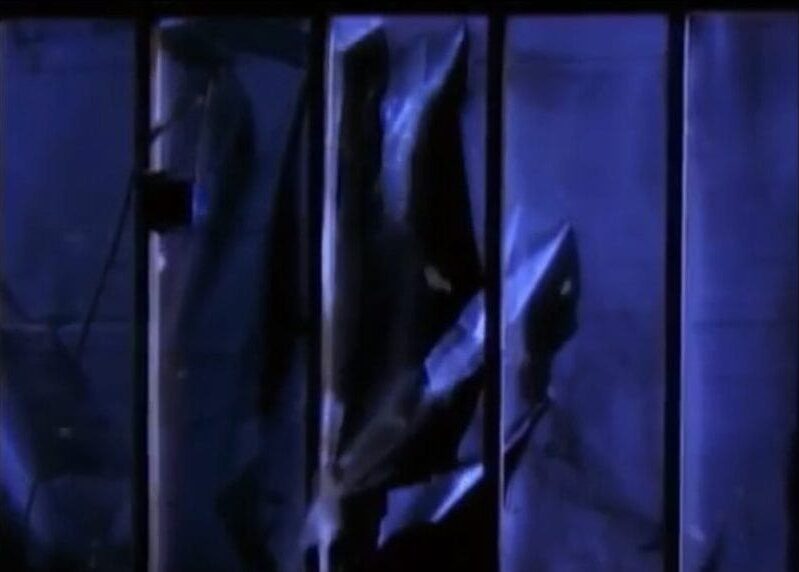
The Log Lady Intro
For an episode that features nods to slasher films, Twin Peaks Episode 21’s Log Lady intro focuses on love:
The heart—it is a physical organ, we all know. But how much more an emotional organ—this we also know. Love, like blood, flows from the heart. Are blood and love related? Does a heart pump blood as it pumps love? Is love the blood of the universe?
Blood and love being equated together is sensible enough, but why not put this in front of the episode where Cooper’s falling for Annie and Gordon’s falling for Shelly? I suspect it’s here to be something to hold onto when stakes are mired in fear. It’s an equivalent gesture to Carl Rodd telling one of his down-on-his-luck tenants, “Don’t sell your blood.” Don’t give up on your source of love and compassion, even when Leo is an omnipresent monster trying to kill his wife and her boyfriend. You can push through this fear with compassion and time. Possibly you can do it in the length of a commercial break, like how Dwayne Milford goes from wanting to murder his brother’s killer with a shotgun to wanting to adopt a child with her. And even if it’s not the deepest love in the world, the slightest hint of compassion could make you second-guess the hurt you’re inflicting on others, as when Evelyn allows James to escape the police officers coming for him.
Dale Cooper
Dale Cooper begins this episode by acting like the pre-flannel self who was in touch with his intuition. He describes exactly how Earle found the vagrant, killed him (down to the stab wound that severed the aorta), brought him silently into the police station, and set him up to reveal the next move of Earle’s all-too-real game. Cooper understands the situation so well that he describes it like he was there. “I can still feel his presence.” Dale is on top of his game again.
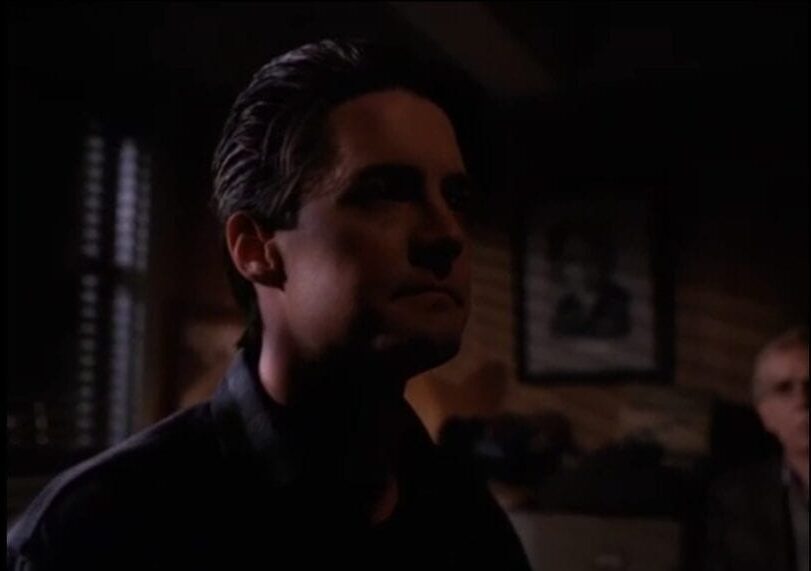
Except soon after, Cooper comes clean to Harry about his past with Earle. Cooper’s fears return, as does a superimposed image of Caroline Earle that at the time was similarly schlocky to that one time Andy had a thought bubble with Little Nicky dressed in a devil costume. But these moments will be seen differently since Part 17, when Dale’s superimposed face says, “We live inside a dream,” after his doppelganger is defeated by Freddie and his green glove. Thoughts that manifest as superimposed image means there’s Lodge-style influence afoot.
There’s a case to be made that Dale’s state of mind goes full-on into fear as he remembers the stakes of his and Earle’s last “game.” How else do we see Cooper fall under a fear-based frequency here? His face fades out into an interstitial shot of blowing trees.
How else do we know Dale’s unanchored from this point forward? Because every time he unknowingly crosses paths with a disguised Earle (beginning next episode), he most certainly does not “feel his presence.”
Fear
Major Briggs arrives at the sheriff station only to pass out. He’s been interrogated by his superiors, and he literally says the word “fear” to Harry and Cooper when he fears that his organization is not ideologically pure. He chooses to wait in the shadows until they need him, but almost everyone else is less aware that they are also in their shadows.
Shelly, feeling alone, falls into a worst-case scenario horror movie not dissimilar to the Double R scene in Part 11 that ends with Bobby meeting a zombie girl. Shelly’s home alone. The lights are going out at random. The doors are locked from the inside. Leo is suddenly awake. A wheelchair appears to move by itself. Worst of all, Leo is an omnipresent monster who stalks Shelly with an ax in the middle of the house while simultaneously attacking Bobby at the front of the house. Shelly feels trapped and alone when Bobby leaves her alone with her problems, and it turns into a literal horror movie.
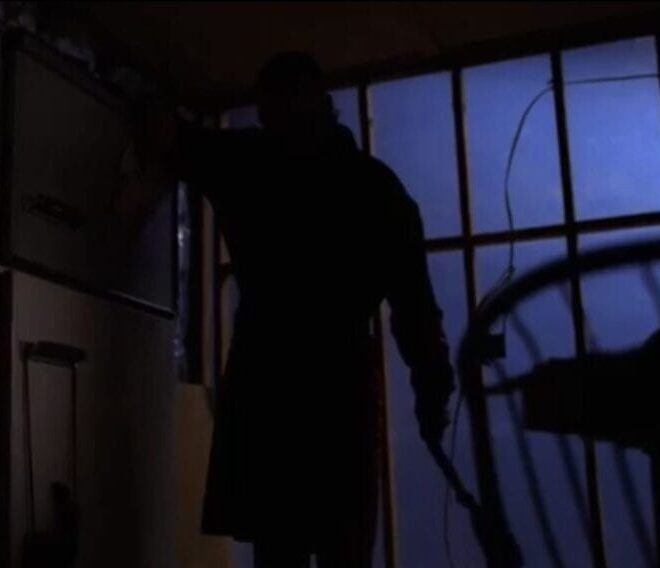
Another fear-based scenario enters the series with the appearance of Thomas Eckhart, complete with fire reflected in his sunglasses. He’s physically embodying the role he will play to Josie, who’s living in her own fear-based scenario where she’s literally become the maid of Catherine, while her dead husband Andrew has yet to reveal he’s alive and able to prove she tried to kill him. Everything is going wrong for Josie, who in a few episodes will literally die of fear, according to local medical experts.
Even Andy is being driven by his fears. Ever since that thought balloon of Nicky in the devil costume, Andy has followed Dick’s fears to the worst-case scenario that Nicky killed his parents as a young child. Andy believes it so much that he even warns Lucy about his perceived worries.
It takes Doc Hayward telling the story of Nicky’s parents before understanding can be achieved and the Little Nicky plotline can disappear, never to be seen or mentioned again (like Hawk seeing those Lodge curtains in the woods in Part 2).
Ben Horne
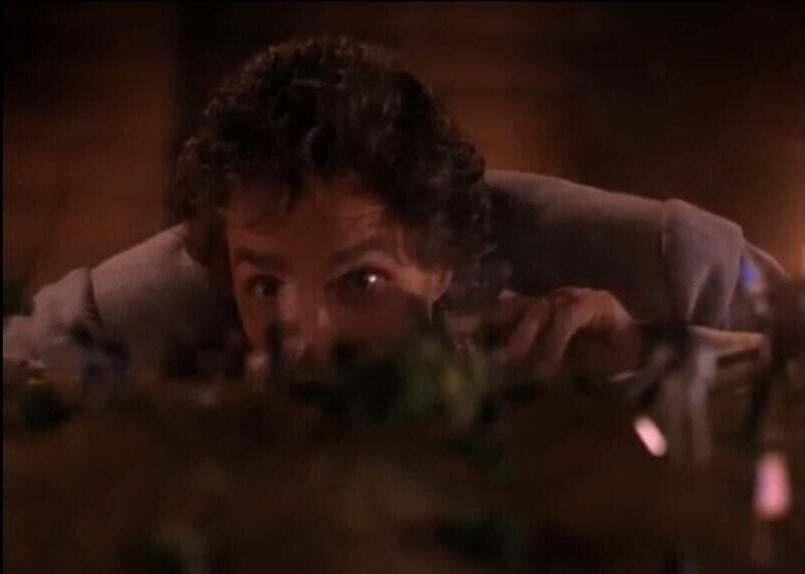
The main reason why I think there’s a frequency of reality being influenced by BOB is the shape of Ben Horne’s particular delusion. He loses everything when Catherine wins the war for the Ghostwood land, and he descends into another state while he sorts through his fears of what will happen to him now. What I find fascinating is how by-the-Lodge-rules his weird Civil War storyline is. Just as words have to be spoken backwards to proceed forward, Ben’s storyline is filled with opposites, mirror images, or reversals:
- Ben lives as a name he is not—Robert E. Lee—the same as Richard and Linda, even zebras and muffins.
- Ben’s location is on the opposite side of the country: the Civil War was in the Southeast, and Ben lives in the Northwest.
- He’s winning a war that was lost.
- It’s a delusion he’s slowly submerged in after he’s defeated by Catherine for the Mill deal. The previous episode is the last time Ben is connected to reality—when he acknowledges Catherine by name. Though by the end of that scene, Catherine lets him dive further into the delusion: “Kiss me, General Lee!” This episode, he’s in military dress with his miniatures, blowing the confederate flag in the wind with a fan he himself turns on. Next episode, everyone observing Ben will be in period dress, including Audrey as a Southern belle, complete with parasol. All this is to say that diving fully into the delusion will help you realize you need to wake up (“and you were there, and you were there”).
- What we see from the inside with his daughter Audrey’s Lodge-adjacent state in Season 3, we’re seeing the same kind of delusion with Ben’s Civil War story from the outside…from the point of view of the people trying to get him out of it.
Help’s at Hand
Audrey and Bobby light candles (a source of light!) when talking together about helping Ben. Audrey brings in Dr. Jacoby. Meanwhile, Bobby physically risks his life to save Shelly’s by entering a slasher-movie scenario.
Evelyn, of all people, brings up love, however ham-fisted when she declares hers for James. This feeling brings her to a place where she wants to help James out of the trap she has placed him in. Though this is of course after she manifests the sound of a car crash just as her husband Jeffrey is pulling out of the driveway. Evelyn’s help is hit-or-miss but comes through in the end.
Doctors Hayward and Jacoby consistently help their patients by leaning into their delusions. Hayward’s monologue about Little Nicky’s mom sounds like a stage-play monologue from a Dickens novel. Then he gives Ed advice about Nadine as if she were Ed’s child, saying that everyone should just believe she’s actually 18 now. And Jacoby happily allows Ben’s delusion to grow even further entrenched while *simultaneously* helping Lanna Budding Milford.
Dr. Jacoby, Balanced Between Love and Fear
Jacoby is at the Sheriff’s station presenting his case for Lana’s being harmless, where he assures Harry and the guys he was with her for the past 24 hours. But I sure didn’t see her at Horne’s Civil War locale.
There’s no way Scott Frost knew about different coexisting frequencies being a thing in Twin Peaks back when he wrote Episode 21. Most likely, Jacoby’s being in two places at the same time is probably a remnant of changes made in different drafts of a script being written at the intense speed of television series production, and no one noticed in time to change it. But being in an episode where Leo is also omnipresent, coupled with the way the supernatural aspects of the show work, this makes more sense after Season 3 than it did before.

Jacoby’s just as influenced by the dreamlike Lodgespace as anybody else, but he’s also wearing those glasses that balance him better than most. So not only does he see the fear-based nightmare frequency, but he can also feel the overly positive dreamlike frequency that could allow all the males in the room to be drawn to Lana’s sexual powers. Even though it’s a positive, humorous frequency, it still operates on dream logic. So, Cooper can allow a man with a shotgun to go into a room with a woman he wants to kill because Cooper knows with a commercial break’s length of time that the Mayor will fall under this spell as well.
How can I explain how this positive frequency exists? Maybe it could be as simple as this: One man’s dream is another man’s nightmare, like what happens between Jean Renault and Dale Cooper in the previous episode. It’s Cooper’s dream of law and order and stopping bad guys versus Renault’s nightmare of his profitable world of preying on high schoolers falling down around him. Cooper’s positive frequency vs. Renault’s negative frequency. And even when things are going well for you, if you’re using a tool like a weapon, fear is at the forefront, and you’re on a negative frequency.
And Then There’s Windom Earle
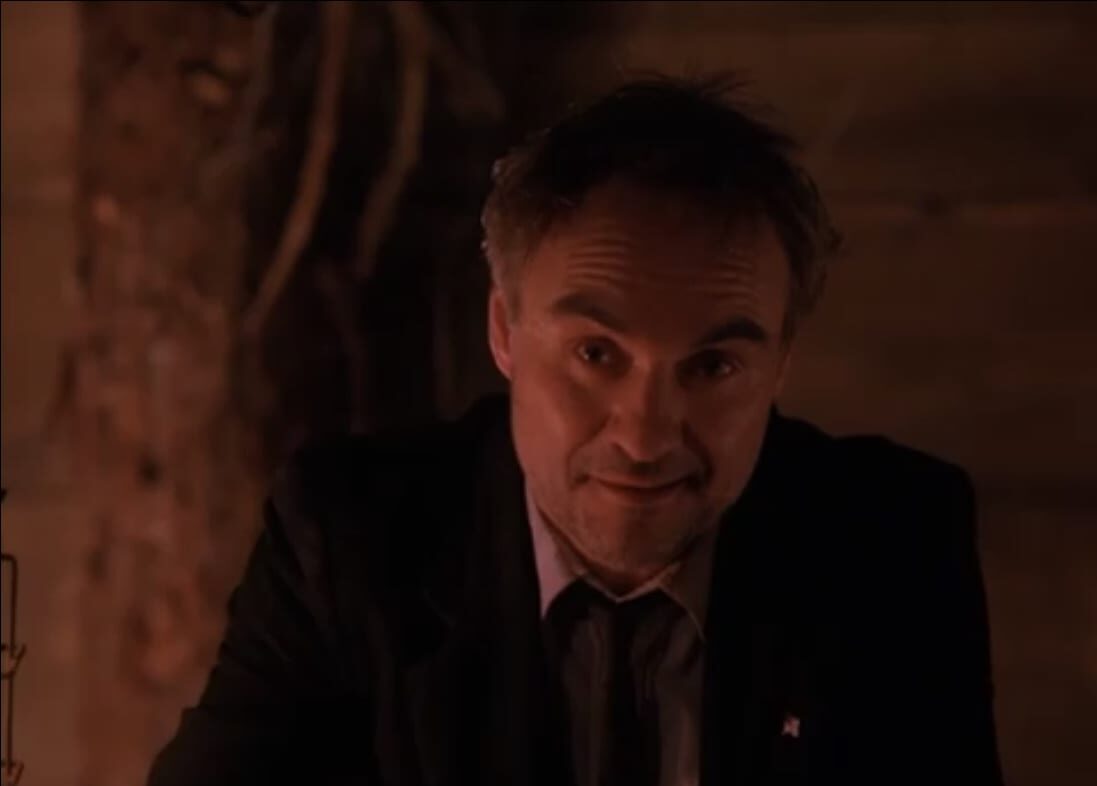
Our first glimpse of Earle gives me the impression that his mind really could be a diamond. You could make a case that Earle has yet to find the frequency of Lodgespace. Here, we get that calm madman that Cooper was describing. We get a calm man aware of his surroundings enough to stay in the shadows, knowing when to have his gun at the ready and when not to. When to reveal himself from the shadows.
But then the wind blows out the candle. The air of Twin Peaks enters, and Leo has verified with his own eyes that Earle is here. Earle’s “wants” will align with that feeling in the air, and next thing you know he’s Puck from A Midsummer’s Night Dream playing the flute in his long johns, a trickster spirit of Twin Peaks, captured within those dreamy, dangerous woods along with everyone else.

